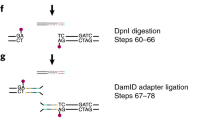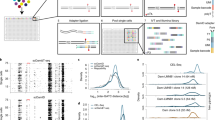Abstract
A fundamental question in gene regulation is how cell-type-specific gene expression is influenced by the packaging of DNA within the nucleus of each cell. We recently developed Split-Pool Recognition of Interactions by Tag Extension (SPRITE), which enables mapping of higher-order interactions within the nucleus. SPRITE works by cross-linking interacting DNA, RNA and protein molecules and then mapping DNA–DNA spatial arrangements through an iterative split-and-pool barcoding method. All DNA molecules within a cross-linked complex are barcoded by repeatedly splitting complexes across a 96-well plate, ligating molecules with a unique tag sequence, and pooling all complexes into a single well before repeating the tagging. Because all molecules in a cross-linked complex are covalently attached, they will sort together throughout each round of split-and-pool and will obtain the same series of SPRITE tags, which we refer to as a barcode. The DNA fragments and their associated barcodes are sequenced, and all reads sharing identical barcodes are matched to reconstruct interactions. SPRITE accurately maps pairwise DNA interactions within the nucleus and measures higher-order spatial contacts occurring among up to thousands of simultaneously interacting molecules. Here, we provide a detailed protocol for the experimental steps of SPRITE, including a video (https://youtu.be/6SdWkBxQGlg). Furthermore, we provide an automated computational pipeline available on GitHub that allows experimenters to seamlessly generate SPRITE interaction matrices starting with raw fastq files. The protocol takes ~5 d from cell cross-linking to high-throughput sequencing for the experimental steps and 1 d for data processing.
This is a preview of subscription content, access via your institution
Access options
Access Nature and 54 other Nature Portfolio journals
Get Nature+, our best-value online-access subscription
$29.99 / 30 days
cancel any time
Subscribe to this journal
Receive 12 print issues and online access
$259.00 per year
only $21.58 per issue
Buy this article
- Purchase on Springer Link
- Instant access to full article PDF
Prices may be subject to local taxes which are calculated during checkout





Similar content being viewed by others
Data availability
Example DNA SPRITE datasets have been deposited on the 4DN Data Portal24 under accession numbers 4DNFI8ZROQ87 and 4DNFIY9HL35V.
Code availability
The DNA SPRITE software is available for download on the Guttman Laboratory github page at https://github.com/GuttmanLab/sprite-pipeline/43. Version v0.2 is explained in detail within this paper.
References
Martin, C. et al. Genome restructuring in mouse embryos during reprogramming and early development. Dev. Biol. https://doi.org/10.1016/j.ydbio.2006.01.009 (2006).
Dixon, J. R. et al. Chromatin architecture reorganization during stem cell differentiation. Nature 518, 331–336 (2015).
Bonev, B. & Cavalli, G. Organization and function of the 3D genome. Nat. Rev. Genet. 17, 772–772 (2016).
Pombo, A. & Dillon, N. Three-dimensional genome architecture: players and mechanisms. Nat. Rev. Mol. Cell Biol. 16, 245–257 (2015).
Lieberman-aiden, E. et al. Comprehensive mapping of long-range interactions reveals folding principles of the human genome. Science 326, 289–294 (2009).
de Laat, W. & Dekker, J. 3C-based technologies to study the shape of the genome. Methods 58, 189–191 (2012).
Dekker, J. Capturing chromosome conformation. Science 295, 1306–1311 (2002).
Dixon, J. R. et al. Topological domains in mammalian genomes identified by analysis of chromatin interactions. Nature 485, 376–380 (2012).
Rao, S. S. P. et al. A 3D map of the human genome at kilobase resolution reveals principles of chromatin looping. Cell 159, 1665–1680 (2014).
Dekker, J. Mapping the 3D genome: aiming for consilience. Nat. Rev. Mol. Cell Biol. 17, 741–742 (2016).
Lawrence, J. B. & Clemson, C. M. Gene associations: true romance or chance meeting in a nuclear neighborhood? J. Cell Biol. 182, 1035–1038 (2008).
Bintu, B. et al. Super-resolution chromatin tracing reveals domains and cooperative interactions in single cells. Science 362, eaau1783 (2018).
Takei, Y. et al. Integrated spatial genomics reveals global architecture of single nuclei. Nature 590, 344–350 (2021).
Quinodoz, S. A. et al. Higher-order inter-chromosomal hubs shape 3D genome organization in the nucleus. Cell https://doi.org/10.1016/j.cell.2018.05.024 (2018).
Beagrie, R. A. et al. Complex multi-enhancer contacts captured by genome architecture mapping. Nature 543, 519–524 (2017).
Zheng, M. et al. Multiplex chromatin interactions with single-molecule precision. Nature 566, 558–562 (2019).
Olivares-Chauvet, P. et al. Capturing pairwise and multi-way chromosomal conformations using chromosomal walks. Nature 540, 296–300 (2016).
Tavares-Cadete, F., Norouzi, D., Dekker, B., Liu, Y. & Dekker, J. Multi-contact 3C reveals that the human genome during interphase is largely not entangled. Nat. Struct. Mol. Biol. 27, 1105–1114 (2020).
Vermeulen, C. et al. Multi-contact 4C: long-molecule sequencing of complex proximity ligation products to uncover local cooperative and competitive chromatin topologies. Nat. Protoc. 15, 364–397 (2020).
Vogel, M. J., Peric-Hupkes, D. & van Steensel, B. Detection of in vivo protein–DNA interactions using DamID in mammalian cells. Nat. Protoc. 2, 1467–1478 (2007).
Chen, Y. et al. Mapping 3D genome organization relative to nuclear compartments using TSA-Seq as a cytological ruler. J. Cell Biol. https://doi.org/10.1083/jcb.201807108 (2018).
Yáñez-Cuna, J. O. & van Steensel, B. Genome–nuclear lamina interactions: from cell populations to single cells. Curr. Opin. Genet. Dev. 43, 67–72 (2017).
Vangala, P. et al. High-resolution mapping of multiway enhancer–promoter interactions regulating pathogen detection. Mol. Cell 80, 359–373.e8 (2020).
Dekker, J. et al. The 4D nucleome project. Nature https://doi.org/10.1038/nature23884 (2017).
Dudchenko, O. et al. De novo assembly of the Aedes aegypti genome using Hi-C yields chromosome-length scaffolds. Science https://doi.org/10.1126/science.aal3327 (2017).
Dudchenko, O. et al. The Juicebox Assembly Tools module facilitates de novo assembly of mammalian genomes with chromosome-length scaffolds for under $1000. Preprint at bioRxiv https://doi.org/10.1101/254797 (2018).
Quinodoz, S. A. et al. RNA promotes the formation of spatial compartments in the nucleus. Cell https://doi.org/10.1016/j.cell.2021.10.014 (2021).
Stoeckius, M. et al. Simultaneous epitope and transcriptome measurement in single cells. Nat. Methods https://doi.org/10.1038/nmeth.4380 (2017).
Gaublomme, J. T. et al. Nuclei multiplexing with barcoded antibodies for single-nucleus genomics. Nat. Commun. https://doi.org/10.1038/s41467-019-10756-2 (2019).
Arrastia, M. V. et al. Single-cell measurement of higher-order 3D genome organization with scSPRITE. Nat. Biotechnol. https://doi.org/10.1038/s41587-021-00998-1 (2021).
Blecher-Gonen, R. et al. High-throughput chromatin immunoprecipitation for genome-wide mapping of in vivo protein–DNA interactions and epigenomic states. Nat. Protoc. 8, 539–554 (2013).
Martin, M. Cutadapt removes adapter sequences from high-throughput sequencing reads. EMBnet J. https://doi.org/10.14806/ej.17.1.200 (2011).
Amemiya, H. M., Kundaje, A. & Boyle, A. P. The ENCODE Blacklist: identification of problematic regions of the genome. Sci. Rep. https://doi.org/10.1038/s41598-019-45839-z (2019).
Quinlan, A. R. & Hall, I. M. BEDTools: a flexible suite of utilities for comparing genomic features. Bioinformatics 26, 841–842 (2010).
Zhang, J. et al. ChIA-PET analysis of transcriptional chromatin interactions. Methods 58, 289–299 (2012).
Mumbach, M. R. et al. HiChIP: efficient and sensitive analysis of protein-directed genome architecture. Nat. Methods 13, 919–922 (2016).
Jäger, R. et al. Capture Hi-C identifies the chromatin interactome of colorectal cancer risk loci. Nat. Commun. 6, 6178 (2015).
Schoenfelder, S., Javierre, B.-M., Furlan-Magaril, M., Wingett, S. W. & Fraser, P. Promoter Capture Hi-C: high-resolution, genome-wide profiling of promoter interactions. J. Vis. Exp. https://doi.org/10.3791/57320 (2018).
Fang, R. et al. Mapping of long-range chromatin interactions by proximity ligation-assisted ChIP-seq. Cell Res. https://doi.org/10.1038/cr.2016.137 (2016).
Engreitz, J. M. et al. The Xist lncRNA exploits three-dimensional genome architecture to spread across the X chromosome. Science 341, 1237973–1237973 (2013).
Terranova, C. et al. An integrated platform for genome-wide mapping of chromatin states using high-throughput chip-sequencing in tumor tissues. J. Vis. Exp. https://doi.org/10.3791/56972 (2018).
Daley, T. & Smith, A. D. Predicting the molecular complexity of sequencing libraries. Nat. Methods https://doi.org/10.1038/nmeth.2375 (2013).
Quinodoz, S. A. et al. SPRITE: a genome-wide method to map higher-order 3D interactions in the nucleus using combinatorial split-and-pool barcoding. GitHub https://doi.org/10.5281/zenodo.5142570 (2021).
Daley, T. & Smith, A. D. Modeling genome coverage in single-cell sequencing. Bioinformatics 30, 3159–3165 (2014).
Li, W., Gong, K., Li, Q., Alber, F. & Zhou, X. J. Hi-Corrector: a fast, scalable and memory-efficient package for normalizing large-scale Hi-C data. Bioinformatics 31, 960–962 (2015).
Acknowledgements
We thank all members of the Guttman Laboratory for input on the SPRITE protocol; M. Blanco, I. Goronzy and P. Vangala for helpful comments; B. Tabak for insights on cluster size analysis and weighting; C. Lai and P. Russell for initial support with the SPRITE pipeline; I.-M. Strazhnik and S. Knemeyer for illustrations; and G. Napolitan-Witz for producing and editing the SPRITE video. S.Q. is supported by the HHMI Gilliam Fellowship and NSF GRFP Fellowship. P.B. is supported by the UCLA-Caltech MSTP, NIH F30CA247447, the Josephine de Kármán Fellowship Trust and a Caltech Chen Graduate Innovator Grant. N.O. is supported by the American Cancer Society Postdoctoral Fellowship grant number PF-17-240-01. This work was funded by the NIH 4DN (U01 DA040612 and U01 HL130007), the NYSCF, NIH Director’s Early Independence Award (DP5OD012190), CZI Ben Barres Early Career Acceleration Award, Sontag Foundation, Searle Scholars Program, Pew-Steward Scholars program, and funds from Caltech. M.G. is a NYSCF-Robertson Investigator.
Author information
Authors and Affiliations
Contributions
S.A.Q. and M.G. conceptualized the experimental method; S.A.Q., P.B., J.J., E.S. and E.D. developed the experimental method and generated data; P.C., N.O. and M.G. developed the computational method and data analysis tools; S.A.Q, P.B., P.C. and M.G. wrote the manuscript.
Corresponding author
Ethics declarations
Competing interests
S.A.Q. and M.G. are inventors of a patent on the SPRITE method.
Additional information
Peer review information Nature Protocols thanks Xiaohua Shen and the other, anonymous, reviewer(s) for their contribution to the peer review of this work.
Publisher’s note Springer Nature remains neutral with regard to jurisdictional claims in published maps and institutional affiliations.
Related links
Key reference using this protocol
Quinodoz, S. et al. Cell 174, 744–757.e24 (2018): https://doi.org/10.1016/j.cell.2018.05.024
Extended data
Extended Data Fig. 1 DNA sizes postfragmentation by DNase for human GM12878 cells.
As with mouse ES cells (or any other cell type we have tested), for human GM12878 cells, we optimize DNAse digestion to obtain DNA sized with a range of 50–1,000 base pairs with an average size between 200 and 300 base pairs.
Supplementary information
Supplementary Information
Supplementary Methods.
Supplementary Video 1
The main experimental steps of the SPRITE method are shown, including split-and-pool barcoding and pre-library amplification steps. A conceptual overview of the SPRITE method is also provided. Please see https://youtu.be/6SdWkBxQGlg for a higher resolution version of this video.
41596_2021_633_MOESM3_ESM.xlsx
Supplementary Table 1 Calculate number of molecules for NHS coupling and the number of reads required to sequence each SPRITE library to saturation. (Sheet 1) To calculate the amount of lysate to couple to NHS-activated beads, enter the average size (bp) and concentration (ng/ul) of DNA in the DNAse digested lysate. This spreadsheet will calculate the number of DNA molecules in the DNAse digested lysate and determine the µL of lysate to couple. (Sheet 2) To determine the amount of reads required to sequence each SPRITE library aliquot to saturation, estimate the number of unique molecules pre-PCR from the final library concentrations using the library molarity and number of cycles.
41596_2021_633_MOESM4_ESM.xlsx
Supplementary Table 2 Sequences of the SPRITE barcodes. All sequences of SPRITE barcodes (DPM, Terminal, Odd, Even) and the indexed Illumina sequencing primers are provided.
Rights and permissions
About this article
Cite this article
Quinodoz, S.A., Bhat, P., Chovanec, P. et al. SPRITE: a genome-wide method for mapping higher-order 3D interactions in the nucleus using combinatorial split-and-pool barcoding. Nat Protoc 17, 36–75 (2022). https://doi.org/10.1038/s41596-021-00633-y
Received:
Accepted:
Published:
Issue Date:
DOI: https://doi.org/10.1038/s41596-021-00633-y
This article is cited by
-
Nanogenosensors based on aptamers and peptides for bioelectrochemical cancer detection: an overview of recent advances in emerging materials and technologies
Discover Applied Sciences (2024)
-
3D genomics and its applications in precision medicine
Cellular & Molecular Biology Letters (2023)
-
HiCognition: a visual exploration and hypothesis testing tool for 3D genomics
Genome Biology (2023)
Comments
By submitting a comment you agree to abide by our Terms and Community Guidelines. If you find something abusive or that does not comply with our terms or guidelines please flag it as inappropriate.



